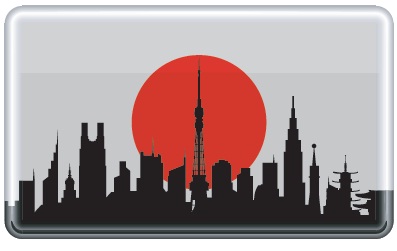by Danielle Tate-Stratton
While moving back to your home country can be a great way to reconnect with family and friends, reengage in traditions you left behind, and, for some, finally feel ‘at home’ again, there are inevitably going to be things you miss about living in Tokyo. Luckily, a network of ‘Little Tokyo’ or ‘Japantown’ neighborhoods around the world can give you a taste of whatever it is that you’re missing from the Big Mikan. Here is a brief rundown of some of the biggest and most active Little Tokyo neighborhoods around the world.
The US is home to three official Japantowns, all located on the West Coast, in Los Angeles, San Jose, and San Francisco. LA’s Little Tokyo, once 30,000 residents strong is now home to 1,000 people and covers roughly four large city blocks. Despite being lightly populated, the area serves as a cultural, culinary, and artistic center for Japanese residents living in nearby areas. It features the Japanese American National Museum, several public sculptures, two Japanese gardens, and an annual tofu festival in August. The area also features noodle shops, yakiniku and shabu shabu restaurants, a Kinokuniya bookstore, and a New Otani Hotel, as well as several temples and shrines including the Zenshuji Soto Mission, which is the first Soto Zen temple in North America. http://ltcc.janet.org
Nearby San Francisco is home to the six-block Nihonmachi or “Little Osaka” area. Currently the largest Japantown in North America, the area features the expected shops and restaurants, but it’s main attraction is the nearly forty-year-old Japan Center which features three malls as well as a fivestorey, concrete, Peace Pagoda. If you can, plan your trip around The Northern California Cherry Blossom Festival, which is held for two weekends each April, or visit in August for the Nihonmachi Street Fair, which is held one weekend per year. Visit www.sfjapantown.org for specific listings.
Completing the West Coast trio of official Japantowns is San Jose’s Nihonmachi area. Originally settled by Japanese citizens returning from internment camps, the area is just north of downtown San Jose and features the Japanese American Museum of San Jose, San Jose Taiko, a 35-year-old performance group, and specialty shops selling handmade tofu and sweet, artisan treats which have even been requested by the Emperor (from the Shuei-do Manju Shop). The local neighborhood association also lists a variety of classes in traditional Japanese arts ranging from shamisen to koto, ikebana to kimono dressing. www.japantownsanjose.org
Heading further south, to the Liberdade district of Sao Paulo, you arrive at the largest community of Japanese living outside of Japan with roughly half a million Brazilians of Japanese descent occupying the area. Liberdade boasts a weekly Sunday market, fresh Asian produce markets, and the Museum of Japanese Immigration.
Europe also has a large population of Japanese expats and features several Little Tokyo areas as a result. Some estimates suggest that the third-largest concentration of Japanese living outside of Japan is in Dusseldorf, Germany. Located on and around Immermann Street, Dusseldorf’s Japanese area is home to a Nikko Hotel, plus shops, restaurants, and large grocery stores where you can find all sorts of Japanese delicacies including fresh sushi. One of the biggest attractions in the area is just across the Rhine River in the neighborhood of Niederkassel. The EKO House of Japanese Culture features the only Japanese (Buddhist) Temple in Europe, a traditional teahouse, and a Japanese garden. The center features tea ceremonies, garden parties, celebrations of Buddhist holidays, and even, in order to help facilitate its main goal of East-West exchange, a 75-seat German-Japanese preschool, as well as a Japanese library. The library includes children’s books as well as a collection of religious and philosophical texts, with an emphasis on Buddhism.
Paris, which is also home to a large population of Japanese expats, boasts a small but thriving Tokyo-sur-Seine tucked away between the Louvre and the Opéra Garnier. Although not too many of France’s 20,000 Japanese live in the area, it is a cultural center and home to a sake distributor and several restaurants and shops which refer to the Japanese as locals and the French as foreigners. Of course, the area is also a prime location for Japanese shopping with bookstores, grocery stores, and other Japanese retailers. It is seen as a cheaper alternative to the world-famous Champs Elysees.
While not every major city has an officially designated Little Tokyo or Japantown area, many have concentrated areas of Japanese restaurants and Japanese stores. For instance, in New York, MUJI is unveiling a 5,000 square foot flagship store in the New York Times Building just in time for this year’s holiday season, complimenting the ‘MUJI@MoMA’ already open at the Museum of Modern Art. Although they aren’t concentrated in one area, there are dozens of Japanese restaurants and cafes in the Big Apple, as well as bakeries, art galleries, antique shops, and community meet-ups.
Back across the pond, London, too, doesn’t have an official Japantown, but head to Leicester Square for a concentration of Japanese restaurants including Nobu and Benihana. If you fancy a bit of shopping, MUJI also has roughly ten outlets in central London, including one in nearby Covent Garden, just one tube stop away.
Even if the city you next find yourself in doesn’t have a designated Little Tokyo or Nihonmachi, chances are there will be a collection of restaurants and shops, plus an event or two in every mid-sized and bigger city to satisfy your appetite for all things Japanese. Failing that, plan your next trip to one of the bigger Japantowns around the world and experience Japanese culture in a whole new.









